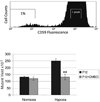Hypoxia/reoxygenation-induced mutations in mammalian cells detected by the flow cytometry mutation assay and characterized by mutant spectrum
- PMID: 20041756
- PMCID: PMC2848454
- DOI: 10.1667/RR1838.1
Hypoxia/reoxygenation-induced mutations in mammalian cells detected by the flow cytometry mutation assay and characterized by mutant spectrum
Abstract
Under hypoxic conditions, cells are more resistant to cell killing by ionizing radiation by a factor of 2.5 to 3, potentially compromising the efficacy of radiotherapy. It has been shown recently that hypoxic conditions alone are sufficient to generate mutations in vitro and in vivo, likely due to the creation of reactive oxygen species (ROS) and a decrease in mismatch and homologous recombination DNA repair activity. These factors are known precursors to the onset of genetic instability and poor prognosis. We have previously characterized the flow cytometry mutation assay and its sensitivity to detect significant mutant fractions induced by genotoxic agents that are not detected by other mammalian assays. Here we measure the mutant fraction induced by hypoxia. CHO A(L) cells cultured at <0.1% O(2) for 24 h generated a significant mutant fraction of 120 x 10(-5) and had growth kinetics and survival characteristics similar to those obtained with other mutagens. We investigated the role of ROS by treating cells with the radical scavenger DMSO, which significantly reduced hypoxia toxicity and mutagenesis. Single cells were sorted from the mutant population, and the resulting clonal populations were stained for five antigens encoded by genes found along chromosome 11 to generate mutant spectra. The mutations were primarily large deletions, similar to those in background mutants, but the frequency was higher. We have demonstrated that hypoxic conditions alone are sufficient to generate mutations in mammalian cells in culture and that the spectrum of mutations is similar to background mutations.
Figures




Similar articles
-
Mutant spectra of irradiated CHO AL cells determined with multiple markers analyzed by flow cytometry.Mutat Res. 2007 Nov 1;624(1-2):61-70. doi: 10.1016/j.mrfmmm.2007.04.005. Epub 2007 Apr 20. Mutat Res. 2007. PMID: 17512559 Free PMC article.
-
Assay to measure CD59 mutations in CHO A(L) cells using flow cytometry.Cytometry A. 2005 Aug;66(2):85-90. doi: 10.1002/cyto.a.20168. Cytometry A. 2005. PMID: 16003719 Free PMC article.
-
EMS mutant spectra generated by multi-parameter flow cytometry.Mutat Res. 2009 Dec 1;671(1-2):6-12. doi: 10.1016/j.mrfmmm.2009.05.005. Epub 2009 May 20. Mutat Res. 2009. PMID: 19463836 Free PMC article.
-
Multiparameter analysis of CHO AL mutant populations sorted on CD59 expression after gamma irradiation.Radiat Res. 2008 Nov;170(5):628-37. doi: 10.1667/RR1276.1. Radiat Res. 2008. PMID: 18959460
-
The Fanconi anemia pathway limits the severity of mutagenesis.DNA Repair (Amst). 2006 Aug 13;5(8):875-84. doi: 10.1016/j.dnarep.2006.05.039. Epub 2006 Jul 11. DNA Repair (Amst). 2006. PMID: 16815103 Review.
Cited by
-
The transcriptional factors HIF-1 and HIF-2 and their novel inhibitors in cancer therapy.Expert Opin Drug Discov. 2019 Jul;14(7):667-682. doi: 10.1080/17460441.2019.1613370. Epub 2019 May 9. Expert Opin Drug Discov. 2019. PMID: 31070059 Free PMC article. Review.
-
Establishment of a novel ferroptosis-related lncRNA pair prognostic model in colon adenocarcinoma.Aging (Albany NY). 2021 Oct 5;13(19):23072-23095. doi: 10.18632/aging.203599. Epub 2021 Oct 5. Aging (Albany NY). 2021. PMID: 34610581 Free PMC article.
-
Transient Receptor Potential Ankyrin 1 Activation within the Cardiac Myocyte Limits Ischemia-reperfusion Injury in Rodents.Anesthesiology. 2016 Dec;125(6):1171-1180. doi: 10.1097/ALN.0000000000001377. Anesthesiology. 2016. PMID: 27748654 Free PMC article.
-
Suppressing the malignant phenotypes of glioma cells by lentiviral delivery of small hairpin RNA targeting hypoxia-inducible factor-1α.Int J Clin Exp Pathol. 2013 Oct 15;6(11):2323-32. eCollection 2013. Int J Clin Exp Pathol. 2013. PMID: 24228093 Free PMC article.
-
Tumour hypoxia in driving genomic instability and tumour evolution.Nat Rev Cancer. 2025 Mar;25(3):167-188. doi: 10.1038/s41568-024-00781-9. Epub 2025 Jan 28. Nat Rev Cancer. 2025. PMID: 39875616 Review.
References
-
- Moulder JE, Rockwell S. Tumor hypoxia: its impact on cancer therapy. Cancer Metastasis Rev. 1987;5:313–341. - PubMed
-
- Brizel DM, Scully SP, Harrelson JM, Layfield LJ, Bean JM, Prosnitz LR, Dewhirst MW. Tumor oxygenation predicts for the likelihood of distant metastases in human soft tissue sarcoma. Cancer Res. 1996;56:941–943. - PubMed
-
- Hall EJ. Radiobiology for the Radiologist. 5th. Philadelphia: Lippincott Williams & Wilkins; 2000. pp. 91–111.
-
- Bristow RG, Hill RP. Hypoxia and metabolism. Hypoxia, DNA repair and genetic instability. Nat. Rev. Cancer. 2008;8:180–192. - PubMed
-
- Risom L, Lundby C, Thomsen JJ, Mikkelsen L, Loft S, Friis G, Moller P. Acute hypoxia and reoxygenation-induced DNA oxidation in human mononuclear blood cells. Mutat. Res. 2007;625:125–133. - PubMed
Publication types
MeSH terms
Substances
Grants and funding
LinkOut - more resources
Full Text Sources

